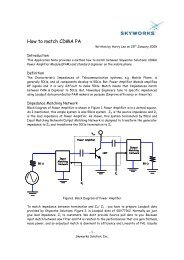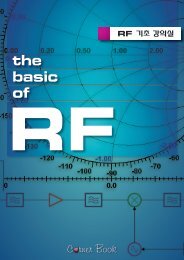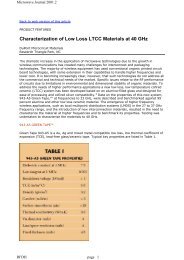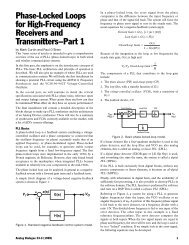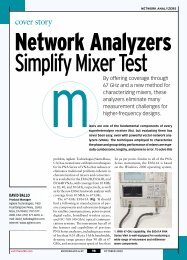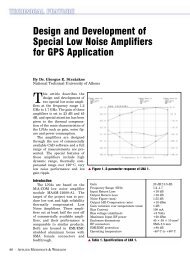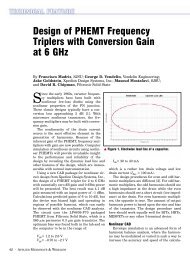Mathcad - ee217projtodonew2.mcd
Mathcad - ee217projtodonew2.mcd
Mathcad - ee217projtodonew2.mcd
Create successful ePaper yourself
Turn your PDF publications into a flip-book with our unique Google optimized e-Paper software.
2000<br />
Ballast Resistor (ohms)<br />
1500<br />
1000<br />
500<br />
0<br />
0 5 10 15 20<br />
Resistance Needed w/ 25 Devices<br />
Resistance Needed w/ 50 Devices<br />
Resistance Needed w/ 75 Devices<br />
Bias Current (mA)<br />
Fig. 14: Ballast Resistor vs Current<br />
Simultaneous Conjugate Matching Analysis<br />
It is desirable from a gain perspective to simultaneously conjugate the input and output of the<br />
amplifier. This maximizes gain, but may not be optimal for noise as we shall see later. If the<br />
device is unilateral (i.e. the reverse isolation, S12, is zero) the conjugate matching impedances<br />
can be calculated directly from S11 and S22. In reality S12 is some non-zero value, so matching<br />
the input will change the impedance at the output. Simultaneous matching can be done<br />
iteratively, which can be tedious and time consuming. An easier method involves solving a<br />
second order equation for the desired values. The derivation of Zpopt is done in [4]. To use the<br />
equation the S-Parameters must first be recalculated with the necessary ballast resistor.<br />
KCL N, I C , s, Z S , Z L<br />
1 1 1<br />
Z S Z bias r b<br />
1<br />
r b<br />
0<br />
0<br />
1<br />
0<br />
0<br />
r b<br />
1<br />
j. ω . 1<br />
C µ<br />
j. ω .<br />
1<br />
C µ<br />
r b<br />
Z π<br />
Z π<br />
j. ω . C µ g m j. ω . 1 1 1<br />
1<br />
C µ<br />
g m<br />
R L Z L r o<br />
r o<br />
1<br />
1<br />
1 1 1<br />
g m g m<br />
Z π r o Z e Z π r o<br />
KCLinv N, I C , s, Z S , Z L KCL N, I C , s, Z S , Z L<br />
1






